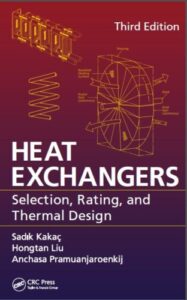Heat Exchangers Selection, Rating, and Thermal Design
Heat Exchangers Selection, Rating, and Thermal Design
This third edition of Heat Exchangers Selection, Rating, and Thermal Design has retained the basic objectives and level of the second edition to present a systematic treatment of the selections, thermal hydraulic designs, and ratings of the various types of heat exchanging equipment. All the popular features of the second edition are retained while new ones are added. In this edition, modifications have been made throughout the book in response to users’ suggestions and input from students who heard lectures based on the sec-ond edition of this book.
There is extensive literature on this subject; however, the information widely scattered. This book provides a systematic approach and should be used as an up-to-date textbook based on scattered literature for senior undergraduate and first year graduate students in mechanical, nuclear, aerospace, and chemical engineering programs who have taken introductory courses in thermodynamics, heat transfer, and fluid mechanics.
You can also read Mechanical Vibrations Sixth Edition in SI Units
Heat Exchangers Selection, Rating, and Thermal Design Content
- Preface
![Heat Exchangers Selection Heat Exchangers Selection]()
- Classification of Heat Exchangers
- Basic Design Methods of Heat Exchangers
- Forced Convection Correlations for the Single-Phase Side of Heat Exchangers
- Heat Exchanger Pressure Drop and Pumping Power
- Micro/Nano Heat Transfer
- Fouling of Heat Exchangers
- Double-Pipe Heat Exchangers
- Design Correlations for Condensers and Evaporators
- Shell-and-Tube Heat Exchangers
- Compact Heat Exchangers
- Gasketed-Plate Heat Exchangers
- Condensers and Evaporators
- Polymer Heat Exchangers
- Appendix A
- Appendix B
- Index
A complete solutions manual is now also available, which provides guidance for approaching the thermal design problems of heat exchangers and for the design project topics suggested at the end of each chapter.
Heat exchangers are vital in power producing plants, process and chemical industries, and in heating, ventilating, air-conditioning, refrigeration systems, and cooling of electronic systems. A large number of industries engaged in designing various types of heat exchange equipment. Courses offered at many colleges and universities on thermal design under various titles.


Comments are closed.